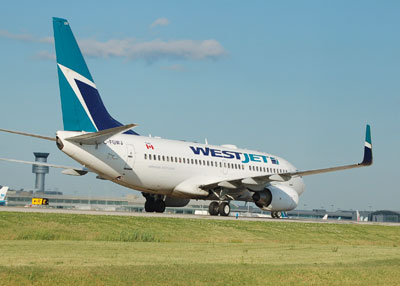
Features
Operations
Alternate Approach: Tapping into the triangle
The Toronto/Montreal/Ottawa triangle is the richest slice of the domestic air transport pie, worth an annual $500 million to $600 million in corporate air travel alone
May 6, 2011 By David Carr
The Toronto/Montreal/Ottawa triangle is the richest slice of the domestic air transport pie, worth an annual $500 million to $600 million in corporate air travel alone. In May, both Air Canada and WestJet ramped up their presence on the triangle, adding capacity and perks not experienced in North America since legacy carriers began stripping amenities out of an economy class ticket and charging for service basics such as baggage check-in and seat selection.

|
|
| “Depending on its success, the triangle could become the service model for WestJet on other routes.” Photo: Brian McNair |
Call it the Porter domino effect after the Toronto-based boutique airline that has carved a market niche by offering retro-style cabin service, complete with boxed snacks and stylish pillbox hats, out of the city’s convenient Island airport. Air Canada has just returned to the Island following a six-year absence (the result of an earlier self-imposed exile) with 15 flights to Montreal using identical Bombardier Q400 aircraft picked up from bankrupt Frontier Airlines. Air Canada Express, as the new service is being branded, is being operated by Sky Regional Airlines.
Of the two national carriers, the stakes may be highest for WestJet, which has slipped behind Porter as the second busiest airline serving the triangle. At 25 per cent and 15 per cent respectively, the airline’s share of the corporate and triangle markets drag behind its 35 per cent share of the overall domestic scene. WestJet will have to shore up both numbers if it is to hit its target of 45 per cent to 50 per cent market share nationwide by 2016, and grab a greater chunk of the premium ticket.
But does WestJet risk being squeezed by Air Canada’s enormous market presence at Pearson and a lack of presence on the Island? “You look at the history of the triangle and Air Canada has done a great job against many entries and exits including names like CP Air, Canadian Airlines and Wardair,” says Sam Barone, CEO of the Canadian Business Aviation Association (CBAA), and a former aviation consultant and president of the Canadian Air Transport Association. “WestJet is a more formidable competitor. It is a major hub carrier with a strong brand name.”
WestJet admits its brand is not as well known on the triangle. So, in addition to adding capacity, the airline has introduced a more business-friendly schedule, free booking changes on same-day flights and a 50 per cent off a next flight voucher as compensation for significant delays or cancellations. The inflight offering has been upgraded to include a complimentary beer or wine (Air Canada has upped the ante with a full bar service) and snack other than the cookies and bar mix that has been a company staple.
Depending on its success, the triangle could become the service model for WestJet on other routes as the single cabin carrier seeks to capture a larger share of the corporate market against Air Canada’s executive class cabin and the pull of Aeroplan.
“The road warrior is not going to be terribly interested in our value proposition,” says Robert Palmer, WestJet’s director of public affairs. “But there are a lot of business travellers who are still flying in the back of the airplane. They are either not flying enough or they aren’t being bumped up. They are price sensitive so our service promise meets their needs.”
As for the ground war, is Toronto Island – recently renamed Billy Bishop Airport after the First World War flying ace – the weak flank in WestJet’s strategy to reinsert itself on the triangle? Not necessarily.
For all its considerable advantages, the Island is a slot constrained airport, heavily tilted in Porter’s favour, offering largely point-to-point service to a narrow slice of the southern Ontario market. With 156 of the 202 available slots, Porter has room to grow. Air Canada Express, not so much. The airline cannot break out of the 30 slots already dedicated to the Montreal service, although it is not clear if it could purchase additional slots from rival Porter, or if those slots belong to the Toronto Port Authority, the operator of Toronto’s downtown jewel. United, Air Canada’s Star Alliance partner, has the remaining 16 slots but is yet to use them.
With close to 60 per cent of the triangle and operations at both Toronto’s commercial airports, Air Canada is comfortably book-ended by Porter at Billy Bishop and WestJet at Pearson. Can WestJet opening up a second beachhead on the triangle be ruled out entirely? Reports that Porter is considering re-launching its stalled IPO are certain to rev up speculation that WestJet will grab an equity stake. It is a rumour brushed off at the airline’s Calgary headquarters. But given the size of the market and what is at stake, every advantage must be seized.
David Carr is a Wings writer and columnist.